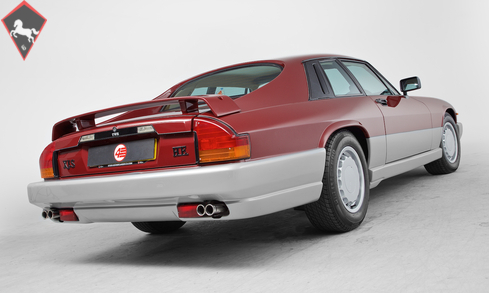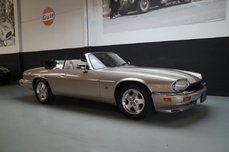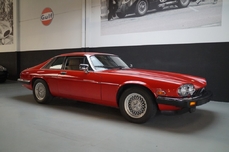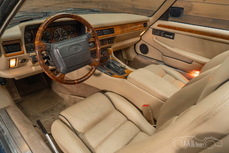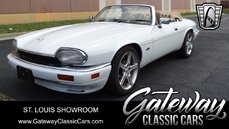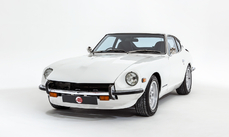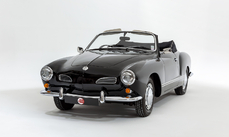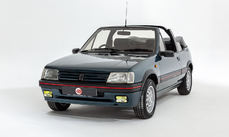Jaguar XJS V12 TWR 1985
Allgemeine Beschreibung :
A glorious TWR XJS V12, one owner, 29k miles.
MODEL HISTORY
The first XJ-S appeared in 1975 as a 1976 model. The development of the car had begun in the late 1960s as project XJ27, with an initial shape set by Malcolm Sayer, but after his death in 1970 it was completed by the in-house Jaguar design team, headed by Doug Thorpe. Power came from the Jaguar V12 petrol engine with a choice of a manual or automatic transmission, but the manual was soon dropped as they were left over from V12 E-Type production.
V12 automobiles were unusual at the time, with notable others coming from Italian luxury sports car makers Lamborghini and Ferrari. The specifications of the XJ-S compared well with both Italian cars; the automatic was able to accelerate to 60 mph in 7.7 seconds and had a top speed of 143 mph. The first series of XJ-S cars had a Borg-Warner Model 12 transmission with a cast-iron case and a bolt-on bell-housing.
Jaguar seized promotional opportunities with the television series The New Avengers and Return of the Saint. The New Avengers featured Mike Gambit who drove an XJ-S. Return of the Saint saw Simon Templar driving an early XJ-S with the number plate "ST 1".
In 1982 Tom Walkinshaw's TWR had entered a team of the V12 XJS's into the European Touring Car Championship, with the cars built to the FIA's Group A touring car rules. The XJS won its first race that season when Walkinshaw and Chuck Nicholson won the XIV Grand Prix Brno; the Jags simply proving too fast for their rival BMW and Alfa Romeo opposition, with Walkinshaw qualifying 5.37 seconds faster than anyone else on the Brno Circuit. The TWR Jaguars were the cars to beat in the ETCC, with Walkinshaw claiming the 1984 ETCC Drivers' Championship. During the championship season the TWR Jaguar team also won the prestigious Spa 24 Hours race with an XJS driven by Walkinshaw.
In 1984 Tom Walkinshaw began to apply what he learned in the ETCC to the road going version of the XJS. The modifications were carried out to production cars at great expense. The end result was a sharper, faster, more focused version of the XJS with styling cues from the racetrack. In fact, Jaguar were so impressed by the TWR modifications and what the car had become that they formed a partnership with TWR and Jaguarsport was made.
Equipment
Climatic air conditioning, Original Clarion head unit, Electric windows, Electric mirrors, Full leather interior, TWR Sports leather steering wheel, TWR bodykit, Rear spoiler, TWR 15-inch alloys, Lockable glove compartment, On board Trip Computer, Embroidered XJS TWR mats.
EXTERIOR
Finished in stunning metallic red with the trademark TWR silver to the bumpers and lower parts of the body, this rare Jaguar looks marvellous in our studio. The paintwork is in great condition having been subject to a bare metal repaint, with no unsightly dents to any of the panels.
The TWR benefits from lowered suspension as well as a full chrome delete, where all of the brightwork is finished in satin black as per the original TWR XJS. The end result is a more aggressive aesthetic than seen on the standard production offering. All in all we have a superb example that even retains the original supplying dealer sticker.
INTERIOR
Once inside you are greeted with seemingly acres of spotless leather upholstery. Being such a low mileage example, the condition of the interior is excellent. There is little or no wear to the bolsters of the seats, which remain both supple and supportive. The TWR steering wheel is in equally good order and retains a nice texture. What's more, the rear seats give the appearance of having never been sat in.
Looking further, the door cards and dash trim present in wonderful shape with no cracks, scratches or fading. The factory-fitted Clarion head unit works just as it did in 1985 as does the climatic AC, which has recently undergone a costly overhaul to include a new condenser, hot water valve body, and a re-gas. The car has also been treated to a new headlining, and the carpets throughout are protected by a fitted set of TWR embroidered mats.
ENGINE & TRANSMISSION
The 5.3-litre V12 has been subject to a full mechanical overhaul. As part of its re-commissioning the car received new plugs, oils, and filters; the fuel tank and fuel lines were also removed, checked, and cleaned. Work has been carried out by several Jaguar specialists, most recently by SPM Motor Works who were given the remit to get the car in A1 mechanical condition.
The Jaguar benefits from an improved flow stainless steel exhaust coupled with subtle TWR quad pipes. Undoubtedly the car has a huge presence on the road; the sound is intoxicating and the engine pulls hard in every gear. Furthermore the gearbox remains silky-smooth whilst giving the option to hold onto the long first and second gears for the twisty stuff.
WHEELS, TYRES & BRAKES
This example is equipped with genuine 15-hole 15-inch TWR alloy wheels, all of which are unmarked and present like new. The wheels are shod in the correct Pirelli P600 tyres.
Also included in the Jaguar's re-commissioning was a complete overhaul of the braking system to include new brakes front to rear; anything worn was either replaced or refurbished. The end result is effortless braking power that stops the car with great urgency when needed.
The TWR sits at least one inch lower than a standard XJS, and so the handling is transformed. However, not wanting it to ride like a go kart the owner opted for a close to standard damper, meaning the car is well placed in corners but still rides like a Jaguar.
HISTORY FILE
This stunning XJS was bought new on 4th January 1985 from Southern Counties Crawely by its one and only owner. Having read a Motorsport Magazine article on the TWR XJS only months before he decided to take the car to TWR, who subsequently transformed his pride and joy into the ultimate version of the XJS. The car was then serviced by Jaguar main dealers until 1990 when it was taken off the road and stored in his garage. The car still bares its last tax disc from 1990.
The extensive re-commissioning has been undertaken by a well respected classic car restoration company who have invested over 400 hours of work into making this rare car one of the very best of its kind. Present in the History File is the original leather Jaguar document holder complete with the dealer-supplied owner's manual. The Jaguar Guarantee, Pre Delivery Inspection Card, and Clarion Stereo Booklet are also included. There is a huge file full of invoices documenting all of the service work carried out over the car's life. The file is complete with a fresh MOT certificate until May 2016.
http://www.4starclassics.com/jaguar-xjs-v12-twr-for-sale/
1985 Jaguar XJS V12 TWR is listed verkauft on ClassicDigest in Kingsley by 4 Star Classics for £25995.
Fakten der Auto
Karosserietyp : Auto Marke : Jaguar Modell : XJS Ausführung : V12 TWR Hubraum : 5.3 Modelljahr : 1985 Karosstyp : Pick up Lage : Hampshire Fahrzeug Anmeldung : Normal
Verkauft
Angaben Zum Verkäufer
Verkauft
People who viewed this Jaguar XJS also viewed similar Jaguar listed at ClassicDigest
Other cars listed for sale by this dealer
über Jaguar
Ah, die Geschichte von Jaguar, von seinen Anfängen als SS Cars Ltd. bis hin zum Höhepunkt mit dem D-Typ und der Straßenversion des ikonischen E-Typs. An dieser Erzählung haftet etwas zutiefst Britisches, und ich werde sie erzählen, wie es ein britischer Journalist tun würde.Die Anfänge:
Unsere Reise in die Welt von Jaguar beginnt in den 1930er Jahren, als ein Unternehmen namens SS Cars Ltd. auftauchte. Trotz des unglücklichen Zufalls ihrer Initialen, die mit den aufkommenden politischen Spannungen in Europa zusammenfielen, begannen sie, stilvolle und leistungsorientierte Autos herzustellen. Der SS 100, der 1936 eingeführt wurde, war ein Symbol für Eleganz und Geschwindigkeit und legte den Grundstein für das, was Jaguar werden sollte.
Die Geburt von Jaguar:
Als der Schatten des Zweiten Weltkriegs näher rückte, entschied sich SS Cars Ltd. klugerweise, sich von den SS-Initialen zu distanzieren. So wurden sie 1945 offiziell zu Jaguar Cars Ltd., ein Name, der bald für britischen Luxus und Leistung stehen würde.
Die XK-Serie:
Die Nachkriegszeit von Jaguar brachte uns den XK 120, eine wahre Sensation im Jahr 1948. Mit seinem schlanken Design und einem leistungsstarken 3,4-Liter-Sechszylindermotor wurde er zum schnellsten Serienauto der Welt. Der XK 120 war die Blaupause für das, was kommen würde - Jaguars, die Stil mit Geschwindigkeit auf einzigartig britische Weise verbanden.
Die Dominanz des D-Typs:
Dann kam der D-Typ, eine wahre Rennlegende. 1954 eingeführt, gewann er in den 1950er Jahren dreimal Le Mans und zeigte die technische Kompetenz von Jaguar. Mit seiner innovativen Monocoque-Konstruktion und der ikonischen Finne hinten war der D-Typ der Höhepunkt von Jaguars Motorsporterfolgen.
Das Auftauchen des E-Typs:
Aber der wahre Wendepunkt kam 1961 mit der Einführung des E-Typs, oft von Enzo Ferrari als "das schönste Auto, das je gebaut wurde" bezeichnet. Seine lange Motorhaube, die geschwungene Karosserie und ein 3,8-Liter-Motor, der atemberaubende Leistung lieferte, machten ihn sofort zu einem Klassiker. Der E-Typ war nicht nur ein Auto; er war ein Kunstwerk auf Rädern und konnte auf der Straße 150 Meilen pro Stunde erreichen.
Straßen- und Rennsporterfolge:
Die Schönheit des E-Typs wurde durch seine Leistung auf der Rennstrecke unterstrichen. Die leichten E-Typen waren bei verschiedenen Rennveranstaltungen besonders erfolgreich und festigten den Ruf von Jaguar als eine Kraft, mit der man im Motorsport rechnen musste.
Das Zeitalter der Raffinesse:
Je tiefer wir in die Geschichte von Jaguar eintauchen, desto mehr erkennen wir, dass die 1950er und 1960er Jahre ein Zeitalter der Raffinesse und Expansion waren. Neben dem großartigen D-Typ und dem ikonischen Aufstieg des E-Typs führte Jaguar Modelle ein, die seinen Ruf für Luxus und Leistung weiter festigten.
Der MK2:
Ende der 1950er Jahre stellte Jaguar den MK2 vor, eine Sportlimousine, die Eleganz mit Leistung vereinte. Diese elegante viertürige Limousine war sowohl bei Bankräubern als auch bei der Polizei aufgrund ihrer außergewöhnlichen Geschwindigkeit und Handhabung beliebt. Der MK2 war ein Symbol für Jaguars Fähigkeit, Raffinesse mit Leistung zu verbinden und hatte auch eine erfolgreiche Rennkarriere.
Der XJ6:
Springen wir ins Jahr 1968, als Jaguar ein Auto auf den Markt brachte, das Jahrzehnte lang Luxuslimousinen definieren würde - den XJ6. Es war ein Meisterwerk der Ingenieurkunst und des Designs, mit einem sanften Reihensechszylindermotor, unabhängiger Hinterachse und einem geräumigen, wunderschön ausgestatteten Innenraum. Der XJ6 war ein Symbol britischer Eleganz und bot eine so sanfte Fahrt, dass es schien, als würde er förmlich über die Straße gleiten. Er wurde zum Flaggschiffmodell für Jaguar und setzte den Maßstab für Luxuslimousinen und zeigte ein Maß an Raffinesse, das die Konkurrenz staunen ließ.
Die Verschmelzung von Klassik und Moderne:
Während der MK2 und der XJ6 die Evolution der Limousinen von Jaguar repräsentierten, bewahrten sie das Engagement der Marke für Leistung und Luxus. Diese Autos gehörten nicht nur auf die Rennstrecke; sie fühlten sich genauso wohl auf den Prachtstraßen wie auf einer entspannten Fahrt durch die englische Landschaft.
Die Herausforderungen des Wandels:
Dennoch sah sich Jaguar mit dem Eintritt der 1970er Jahre, wie viele britische Automobilhersteller, finanziellen Herausforderungen und Veränderungen in der Eigentümerschaft gegenüber. Die Ära von British Leyland brachte sowohl Chancen als auch Schwierigkeiten mit sich, während die Marke durch verschiedene Fusionen und Übergänge navigierte.
Das Erbe des MK2 und des XJ6, zusammen mit dem D-Typ und dem E-Typ, definiert Jaguar weiterhin als einen Hersteller, der zeitlose Eleganz mit einer Leistungsstärke vereint. Diese klassischen Modelle, ob sie über kurvige Straßen gefahren oder als Sammlerschätze geparkt werden, dienen als Zeugnis für die anhaltende Präsenz von Jaguar in der Welt der automobilen Exzellenz.
Die Jaguar-Geschichte, von ihren Anfängen als SS Cars Ltd. bis zur Schaffung von Automobilikonen wie dem E-Typ, dem MK2 und dem XJ6, ist eine Reise, die das Wesen des britischen Automobilbaus widerspiegelt - eine Mischung aus Luxus, Leistung und Stil, die nach wie vor Enthusiasten und Kenner gleichermaßen fasziniert.
